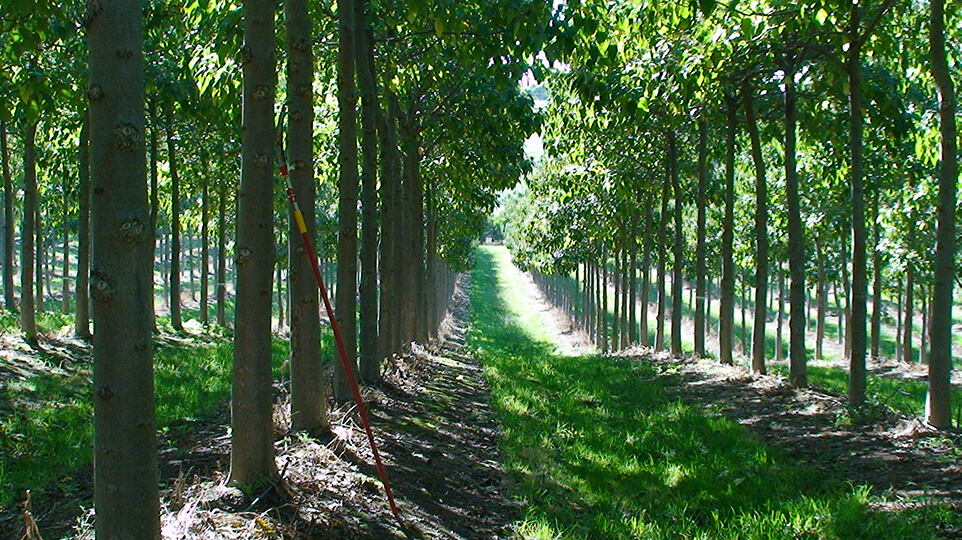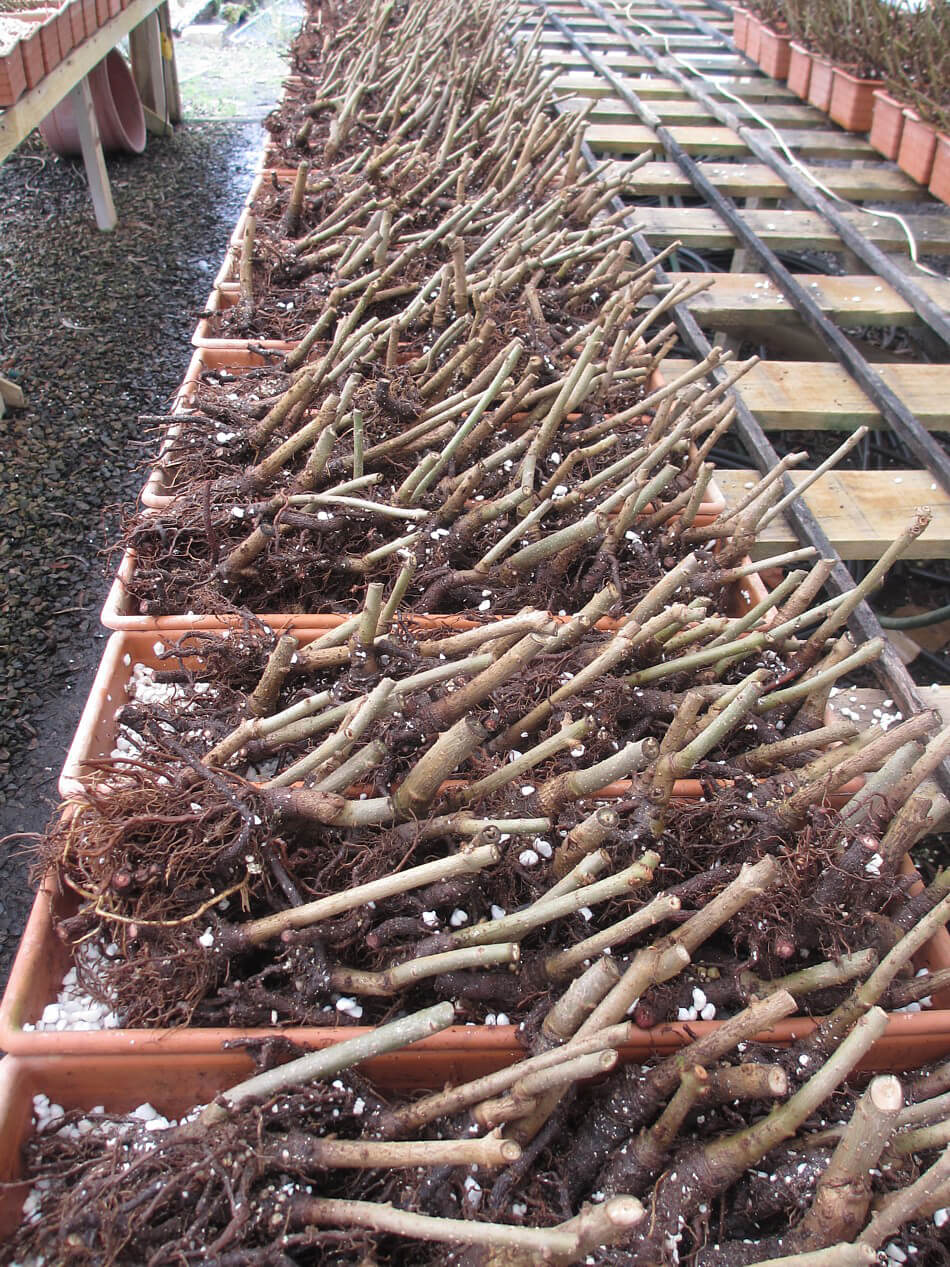Toad Gully Growers supply Paulownia trees as bare root Headstarters™. To see stock availability enter our online store.
Paulownia make a fantastic fast-growing addition to a farm when planted in a small, easily managed grove. They provide shade and fodder, beautiful flowers in spring and can be harvested for timber.
Toad Gully Growers supplied millions of Paulownia seedlings to plantation projects worldwide over 30 years. The motivation was to assist the climate change problem as Paulownia have the potential for rapid growth and carbon sequestration and will regenerate from the stump when harvested for timber. Some projects were successful, but many were not.
We have come to believe Paulownia are not well matched to corporate forestry. The main reasons for failure have been poor site selection, both in terms of soil type and climatic conditions and poor or insufficient management. Greed has played a large part. Often investors have been duped into funding plantations, but insufficient funding has been put into the plantation management and rather has gone to those running the schemes.
Paulownia is a deciduous tree from east Asia, predominately China. The regions Paulownia grow in naturally have good summer rainfall and generally drier cold winter months. This means there are limited regions in Australia suited to the growth of Paulownia.
Paulownia require freely draining fertile soil. They have the potential for amazingly fast growth under the correct conditions but need a lot of water and nutrition during spring to autumn to achieve this fast growth. They are prone to fatal root rot if the water table rises above 1m below the soil surface for more than 3 days, especially in a wet winter when they are dormant, so the soil should be mounded if it is not naturally well drained. Under preferable care, Paulownia grow almost fast enough to watch, so you are quickly rewarded for your efforts!

Toad Gully Growers supply Paulownia Headstarters™, small bare root plants, generally best planted during spring and early summer. Headstarters™ are bare-root Paulownia trees with trimmed trunks. They are ready to plant in the ground and will regenerate a new trunk rapidly with warm weather and correct management.
Headstarters™ have well-developed roots systems about the size of a large hand. These roots have a framework of thick fleshy main roots which contain the energy the tree needs to quickly regenerate in the field. The trunks are trimmed just above a strong node usually at about 150mm tall. They have many reserve buds, ready to sprout, ensuring a new trunk will develop even if some of the buds are damaged - for example by adverse weather.
To grow Paulownia successfully you need to:
If you are growing Paulownia for timber it is important they are not over-crowded. The maximum planting density for a clear fell harvest without thinning is 400 trees per hectare (161 per acre). This can be planted 5 x 5m or 4m in row with the rows 6.25m apart. The latter will save costs on cultivation, dripper line and maintenance works. If you can afford the space planting them wider is better – the figures given here are the closest we suggest you can plant and achieve good results under ideal conditions.
Ornamental planting can be done at various spacing depending on the effect you want. TGG suggest a single row can be planted as close as 2m apart if you want a hedging effect or 4 metres apart for a more stately look. A double row can be planted 3m apart in a zigzag pattern or as wide as 7m apart if you want a lot of light distribution through the canopy. Paulownia will not compete well if planted within 12m of a vigorous tree like pine or eucalypt. We do not recommend planting within 6m from a structure.
The Headstarters™ can be left in the plastic bags in a cool dark place for a matter of only a few days. DO NOT LEAVE IN THE BAGS IN A WARM PLACE as the plants may rot. They ideally should be unpacked and planted within 48 hours of delivery.
If you must store them, remove the plants from the plastic bags as soon as possible and immediately place them upright with their roots covered with potting mix or similar medium in a SUNNY position and keep them moist BUT NOT WET. Under these conditions they will begin to grow, so should not be held any longer than absolutely necessary as if they become too active before planting they are at a greater risk of transplant shock when planted out and may suffer wind damage if they have tall soft growth
Carry the Headstarters™ in a way that keeps them bunched together, cool and moist, and plant them into well cultivated, friable, moist soil. If prone to waterlogging the soil should be cultivated into high mounded beds - at least 60cm higher than original soil level. The roots of the Headstarters™ should not be disturbed. Make sure the general mass of the roots is pointing downwards and the shallowest root is covered by 3cm of soil. Gently firm the soil around the trunk. Tree guards (three bamboo stakes and a plastic sleeve) will help protect the young trees and allow for careful weed spraying around them later.
Exact fertiliser requirements depend on soil type and climate conditions, but as a guide Osmocote 9kg All Purpose Landscape Fertiliser at a rate of 250g (one cup) per tree is a good start. Sprinkle it evenly within a 30cm radius from the trunk. Further application may be needed during the season; the trees should be rich dark green and growth rapid during warm weather. This is a slow release fertiliser designed to last about 6 months. It may take time to begin to release so we suggest you water them in with a liquid fertiliser such as Seasol PowerFeed to help give an initial growth stimulus. Over time, once the trees have dinner plate sized leaves (probably in 6-8 weeks) you could add additional fertiliser to hurry their growth. Pelletised poultry manure such as Dynamic Lifter or Rooster Booster at 1 kg per tree will help them develop larger greener leaves. These act as the solar panels for the young tree, catching the sun's rays and converting the energy into fast growth. At this time, the trees will need to be kept well-watered too as this is when they use a lot of water for the fast growth stage. However, to begin, for the first few weeks after planting, they do not want too much water. They only need the ground to be moist, not wet. Only water heavily once the heat arrives and the trees have very large leaves.
When the weather is warm the trunk will regenerate from the Headstarters™ stump. (However even if it’s warm it generally takes 3 to 6 weeks to sprout, so don’t panic.) Often multiple stems sprout from the many reserve buds on Headstarters™; only the strongest one should be allowed to grow. The best shoots usually grow from low on the stump. Wait until the best trunk shoots are at least 20cm tall, then trim off all but one strong one and remove any portion of the original trunk above the shoot you have selected. This shoot will then grow more strongly and straight, to become the new trunk. Headstarters™ planted in spring and given ideal conditions, may reach between 2 to 4 metres by autumn!
Paulownia can be shaped into tall, stately trees or shorter bushy specimens depending on what you want. The removal of the tips of the branches and even the top portion of the trunk, will force regrowth lower on the stems to produce a dense, compact tree. Multi-trunked bushy trees can be continuously pruned for fodder throughout the growing season. Timber growers will want a tall straight trunk and should gradually lift prune any branches that grow on the first 4 to 6m being sure to always leave at least one third of the height of the trunk covered with leaved branches. It is usually a simple matter of removing the lower branches (generally from late summer to early winter) when they reach 2 to 3 cm diameter. This should prevent large knots in the timber. Be sure not to mistake the thick leaf stalks in the first season for branches! You should not remove the big leaves as this will slow growth. They will drop naturally by mid-winter leaving behind a pattern on the trunk which does not impact the timber.
Contact us. We hope you enjoy growing Toad Gully Growers Paulownia Headstarters™.